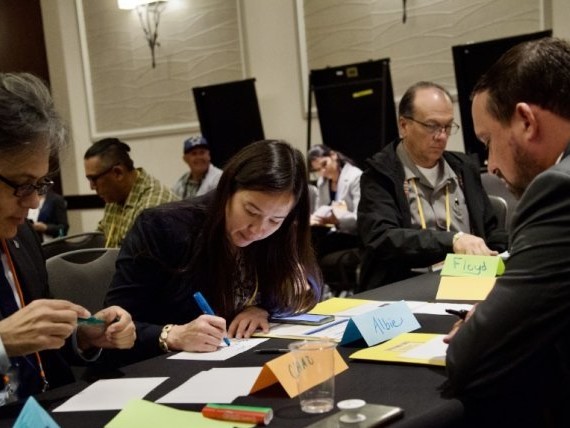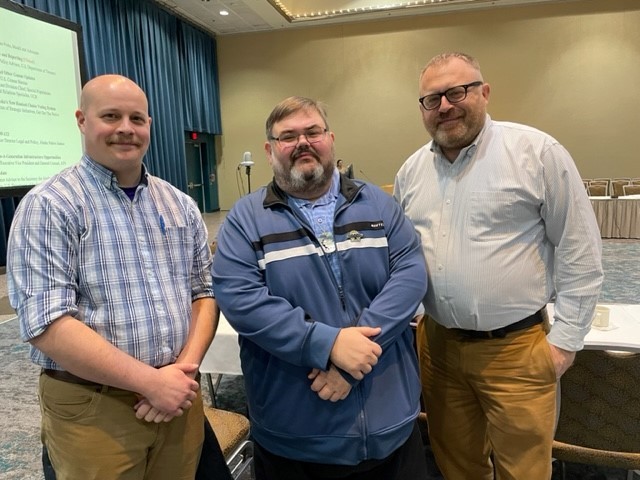Alaska Natives Voice Ideas for Collaboration,
Learn about DOE Funding at Summit
 Kutraluk Bolton, left, and Albie Dallemolle, right, of NANA Regional Corporation joined other tribal leaders in documenting their priorities at the Tribal Clean Energy Summit on Oct. 4-5 in Washington, D.C. Courtesy of Donica Payne.
Alaska Native tribal leaders advocated for their local community’s needs during DOE’s Tribal Clean Energy Summit Oct. 4-5 in Washington, D.C. The Summit was a chance to help federally recognized tribes advance their journey toward tribal clean energy sovereignty, stronger economies, and climate change mitigation.
With a nation-to-nation roundtable discussion of how DOE can strengthen tribal energy sovereignty, 53 tribal representatives took turns telling Energy Secretary Jennifer Granholm about their community’s challenges and desire for DOE collaboration to achieve energy goals. Simultaneously, 38 key tribal energy staff learned from DOE representatives about upcoming funding opportunities through the Bipartisan Infrastructure Law and Inflation Reduction Act.
The Summit was a chance for tribal participants to reveal their challenges of keeping abreast of numerous funding opportunities and application requirements. Alaska Native tribal representatives from remote communities also conveyed their specific difficulties with respect to lack of resources for grant writing and administration, in addition to long-standing inherent challenges of environmental considerations of resource development, elevated energy costs, and limited transportation for supply deliveries.
“We pointed out $3.5 billion in funding we could access in this region. They said we can’t get a grant writer,” noted Curtiss Chamberlain, assistant general counsel for the Calista Corporation. “Some tribes have only one tribal administrator trying to do everything. We can’t administer these grants even if awarded them. There is a large, large disconnect that’s happening in rural Alaska because a lot of these tribes are landless and don’t have any sources of revenue. With Typhoon Merbok hitting western Alaska—the second poorest region in the nation with the highest cost of living [and] no road access—the infrastructure for all of our coastal villages was pretty much destroyed. There are huge, huge needs for our region.”
Those and other needs expressed in the Summit gave DOE leaders the impetus for follow up. “We are open to hearing about ways that we can improve outreach to make everyone feel included. There are a lot of comments about formula grants and a smaller application process. This is a great first step hearing from folks here,” said Tommy Jones, deployment specialist for DOE’s Office of Indian Energy Policy and Programs. “The more things we can do to help, that’s what we want to do.”
Recognizing that the Summit is a good first step, DOE offices are now following up with participants on specific ideas and needs and ways to build networks with one another. As Secretary Granholm said in her roundtable, “DOE is committed more than ever in investing in solutions. As we address energy burdens, it matters that we follow up with words and actions.”
Learn more about the Summit here.
 Dan Smith of the Indian Energy Policy and Programs Office, left, Richard Peterson, president of the Central Council of the Tlingit and Haida Indian Tribes of Alaska, middle, and Givey Kochanowski of AEO, right, met at the AFN Tribal Conference before the Alaska Federation of Natives convention on Oct. 19, 2022.
The Alaska Federation of Natives annual convention Oct. 20-22, 2022 in Anchorage was an opportune time for Arctic Energy Office (AEO) and Office of Indian Energy Policy and Programs (IE) staff to listen to the energy project ideas and general energy concerns of Alaska Natives. This convention—the largest representative annual gathering in the United States of Native peoples—is the principal forum and voice for the Alaska Native community to address public policy and government issues, including those relating to energy. This year's convention convened an estimated 7,000 official delegates and participants from communities across Alaska.
The 2022 Convention theme was "Celebrating Our Unity," which honored the unity among communities, families, and organizations in taking on current and future challenges. After a two-year hiatus due to Covid-19, the participants expressed gratitude to be in person once again to share stories of resilience and hope for the future.
With heritage dancers and singers opening each day's sessions, the three-day convention was packed with discussions on such topics as broadband upgrades to rural communities, micro nuclear, tribal sovereignty, Alaska Native boarding schools, arctic security, and tribal education and workforce initiatives. National and state leaders such as Senators Lisa Murkowski and Dan Sullivan, Gov. Mike Dunleavy, U.S. Rep. Mary Peltola of Alaska, and the White House's Dr. Alondra Nelson provided remarks that underscored their commitments to Alaskans and work to advocate on their behalf.
Also working on Alaska Natives' behalf are the new AFN Navigator Program managers, who are helping Natives to navigate and apply to federal funding opportunities open to their communities. AFN conference participants heard a summary of services that Navigators can provide.
AEO and IE staff also conveyed the message of helping Alaskans to learn more about funding opportunities. Both offices were represented at side-by-side DOE booths at the convention, which provided a great opportunity to meet stakeholders of all ages and interest levels. This included Alaska Natives with clean energy project ideas, scientists interested in climate change research, energy industry representatives, other federal and state agency staff, as well as students and job seekers.
Learn more about the convention here.
 Jodi Mitchell of the Inside Passage Electric Cooperative and AFN Board Member discusses energy priorities with AEO Senior Advisor Givey Kochanowski at the AFN convention on Oct. 20, 2022.
 ARENA partipants visited Kotzebue, Alaska, to learn about the utility's solar and wind projects during the group's July learning opportunity. Courtesy of Amanda Byrd, ACEP.
Geothermal energy is not only a “hot” topic among renewable energy enthusiasts but it’s also the key topic for the 2022 Arctic Remote Energy Networks Academy (ARENA) participants this week in Reykjavík, Iceland. Until Oct. 29, they will be in the Iceland Geothermal Training Program as part of their ongoing studies into renewable energy applications.
Iceland, considered the Geothermal Capital of the World, is a great backdrop for the ARENA group to learn about this natural source of energy generation. To learn more about geothermal energy applications, the group will attend lectures and take excursions across the area, including the site of the old Laugardalur hot springs, geothermal wells and pumping station, Perlan storage tanks and exhibition.
Their journey will also take them to the geothermal field on the Reykjanes Peninsula, the Haustak geothermal fish drying factory, and even soaking in the Blue Lagoon. Lastly, they will visit the Southern Lowlands, the Hellisheidi Power Plant, Set Pipe factory, CO2 production from geothermal wells at Haedarendi, and commercial geothermal greenhouses for tomatoes and flowers plus electrical production at Kópsvatn. The trip will end with a visit to see the scenic Gullfoss waterfall and Thingvellir National Park.
This is the second on-site experience for the 2022 ARENA cohort, which AEO helps to sponsor. The program brings energy professionals together from across the circumpolar North to share knowledge and build community resilience and energy sustainability.
The first on-site was in July in Alaska, when they spent time in Fairbanks learning about Alaska’s unique tribal context, effective techniques for integrating renewable energy resources in microgrids, arctic-relevant building techniques, and low temperature geothermal power. They then visited Kotzebue to see first-hand how Kotzebue Electric Association is radically reducing the community’s reliance on barged-in diesel through utility-scale integration of diesel, wind and solar energy.
Learn about the 2022 cohort here.
- Oct. 25-27, 2022, US Arctic Research Commission Meeting
- Nov. 7-10, 2022, Alaska Miners Association Annual Convention
- Nov. 14-18, 2022, Office of Indian Energy Policy and Programs Annual Program Review
- Nov. 16-17, 2022, Alaska Resources Conference
- Nov. 29-Dec. 1, 2022, Bureau of Indian Affairs-Alaska Region Annual Provider Conference
- Dec. 12-16, 2022, American Geophysical Union Annual Meeting
|